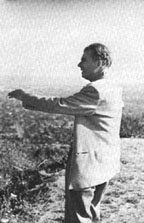Tripping Through History
 |
| Aldous Huxley surveying the hills outside his Los Angeles home, under the influence of his first dose of mescaline. |
|
"Primitive man," wrote Aldous Huxley in 1931,
"explored the pharmacological avenues of escape from the world with astounding
thoroughness. Our ancestors left almost no natural stimulant, or hallucinant, or
stupefacient, undiscovered." To Huxley, the urge for transcendence and visionary
experience was nothing less than a biological imperative. "Always and everywhere," he
asserted, "human beings have felt the radical inadequacy of being their insulated selves
and not something else, something wider, something in the Wordsworthian phrase,
'far more deeply interfused.'... I live, yet not I, but wine or opium or peyotyl or hashish
liveth in me. To go beyond the insulated self is such a liberation that, even when
self-transcendence is through nausea into frenzy, through cramps into hallucinations
and coma, the drug-induced experience has been regarded by primitives and even by the
highly civilized as intrinsically divine." The use of mind-altering drugs as religious sacraments was not restricted to a particular time and place but characterized nearly every society on the planet (with the possible exception of certain Eskimo and Polynesian communities). For the Aztecs there was peyote and ololiuqui, a small lentil-like seed containing lysergic acid; the Aborigines of Australia chewed pituri, a desert shrub; the natives of the Upper Amazon had yage, the telepathic vine. Those who floated into a sacred space after ingesting these substances often projected ecstatic qualities onto the plants themselves. Certain scholars believe that the fabled Soma of the ancient Vedic religion in northem India was actually a psychedelic mushroom, and there is evidence that ergot, from which LSD is derived, was the mysterious kykeon used for over two thousand years by the ancient Greeks in the annual Eleusinian Mysteries.' When Christianity was adopted as the official creed of the Roman Empire in the fourth century, all other religions, including the Mysteries, were banished. Christian propagandists called for the destruction of the pagan drug cults that had spread throughout Europe after the Roman conquest. Like its shamanistic forebears, paganism was rooted in rapture rather than faith or doctrine; its mode of expression was myth and ritual, and those who carried on the forbidden traditions possessed a vast storehouse of knowledge about herbs and special medicaments. The witches of the Middle Ages concocted brews with various hallucinogenic compounds--belladonna, thorn apple, henbane and bufotenine (derived from the sweat gland of the toad Bufo marinus)-- and when the moon was full they flew off on their imaginary broomsticks to commune with spirits. While the passing of time and the destruction of documentary evidence by the church has cancealed the full scope of the ritual use of hallucinogens in Europe, scattered references suggest that a widespread psychedelic underground existed during the Middle Ages. Walter Map, a twentieth-century ecclesiastic, told of certain heretical sects that offered innocent people a "heavenly fold" proclaiming, "Often you will see...angelic visions, in which sustained by their consolation, you can visit whatever place you wish without delay or difficulties." The ruthless suppression of European witchcraft by the Holy Inquisition coincided with attempts to stamp out indigenous drug use among the colonized natives of the New World. The Spanish outlawed peyote and coca leaves in the Americas, and the British later tried to banish kava use in Tahiti. Such edicts were part of an imperialist effort to impose a new social order that stigmatized the psychedelic experience as a form of madness or possession by evil spirits. It wasn't until the late eighteenth century that industrial civilization produced its own "devil's advocate," which spoke in a passionate and Iyrical voice. The romantic rebellion signified "a return of the repressed" as drugs were embraced by the visionary poets and artists who lived as outcasts in their own society. Laudanum, a tincture of opium, catalyzed the literary talents of Coleridge, Poe, Swinhume, De Quincey, and Elizabeth Barrett Browning, while the best-known French writers, including Baudelaire, de Nerval, and Victor Hugo, gathered at Le Club des Haschischins, a protobohemian enclave in Paris founded by Theophile Gautier in 1844. For the visionary poets modern society was the bummer, and they often viewed the drug experience as a tortured means to a fuller existence, to a life more innately human. It was with the hope of alleviating his own tortured mental condition that Antonin Artaud made an intercontinental trek in the 1930s to participate in the peyote ritual of the Tarahumara Indians in the Mexican highlands. Artaud did not undertake such a risky journey as a tourist or an anthropologist but as someone who wished to be healed, as a spiritual exile seeking to regain "a Truth which the world of Europe is losing." The desperate Frenchman experienced a monumental bummer--"the cataclysm which was my body...this dislocated assemblage, this piece of damaged geology." Yet somehow, despite the nightmare visions and the somatic discomfort, he managed to scratch out a perception of the Infinite. "Once one has experienced a visionary state of mind," Artaud wrote in The Peyote Dance, "one can no longer confuse the lie with truth. One has seen where one comes from and who one is, and one no longer doubts what one is. There is no emotion or external influence that can divert one from this reality." |
An excerpt from Acid Dreams: The Complete Social History of
LSD: The CIA, the Sixties and Beyond, by Martin A. Lee and Bruce Shlain
(Grove Press)
Copyright 1985 by Martin A. Lee and Bruce Shlain
The Acid Dreams web site: http://www.levity.com/aciddreams/